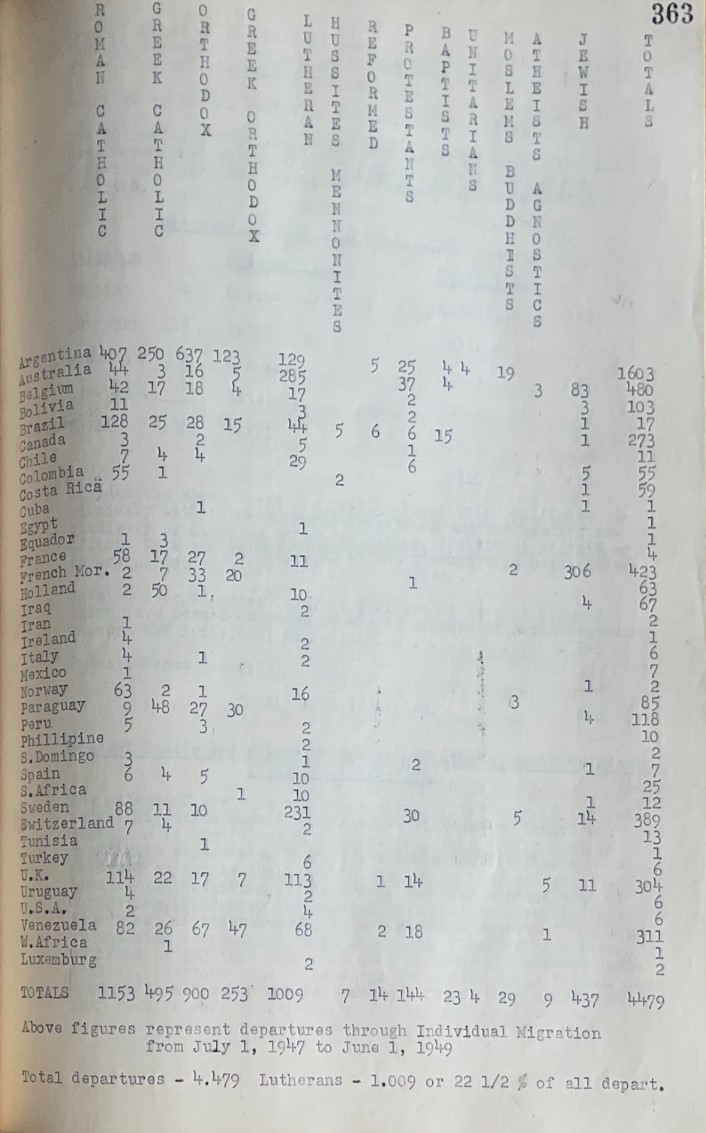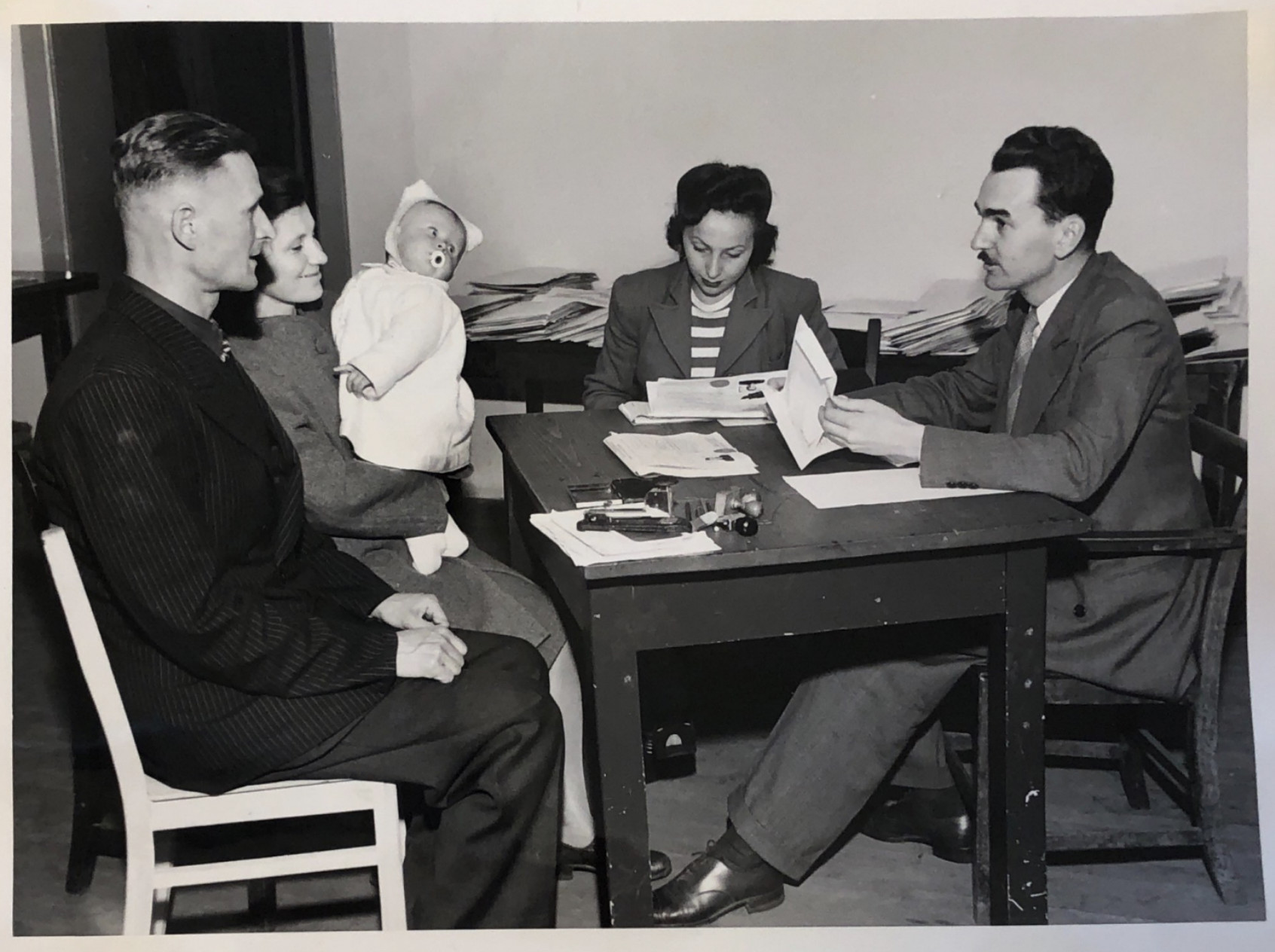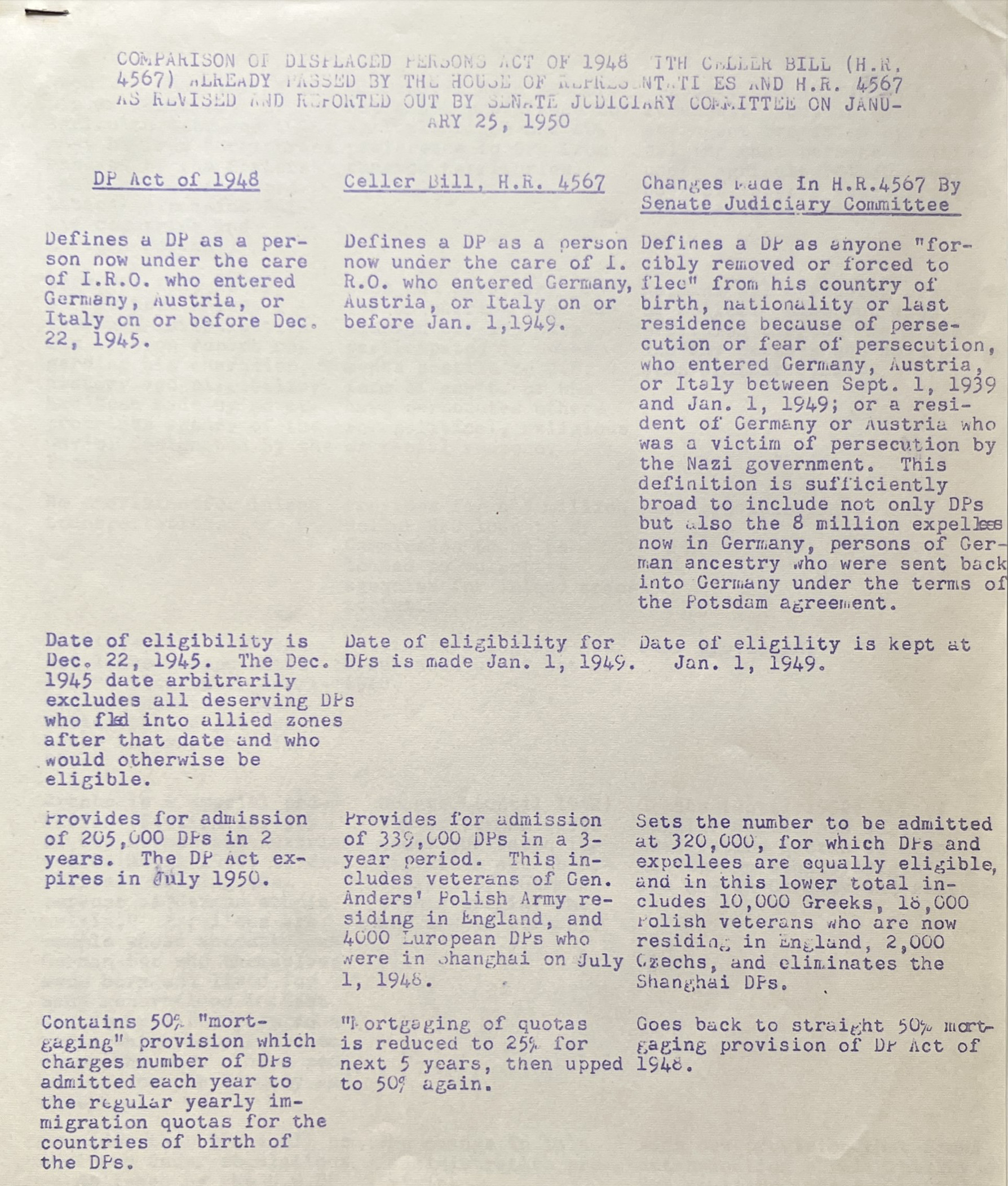U.S. Immigration Policies
Why is it important to understand the U.S. Immigration policies of the time?
1. Our project focuses on the immigration and resettlement of DPs to the U.S., more specifically Minnesota.
2. The U.S. was one of the major countries after WWII that accepted large numbers of displaced persons.
3. These policies determined how the voluntary agencies would operate, the number of DPs admitted, and the resettlement process which they had to go through.
Click on the buttons for quick navigation.
General Background
The Marshall Plan
After WWII, the European economy, as well as the cities destroyed in the war, needed to be rebuilt. In response, the Secretary of State, George Marshall, proposed that the United States provide economic assistance to restore the economic infrastructure of postwar Europe. This proposal was then signed by President Truman on April 3, 1948, and became known as the Marshall Plan. However, the attention to the DP cause came rather late, even though part of the funds from the Marshall Plan did go into DP relief. 1
Harrison Report
However, the Truman administration was more sympathetic than Congress to the DP cause. Out of humanitarian impulse, President Truman issued several statements on behalf of DPs and posed measures to alleviate the situation. One of these measures was when Truman sent Earl G. Harrison to investigate the livelihoods of displaced persons in Germany, soon uncovering the harsh environments they were in. The result of this investigation was the Harrison Report. 2
Truman Directive
On Dec.22, 1945, President Truman issued the Truman Directive, requiring that quotas be specific to people considered displaced persons. The directive largely accelerated the immigration process and permitted voluntary agencies (VAs) to provide a “corporate affidavit.” This means the VAs should guarantee that its clients would not be a public charge. The VAs interviewed and selected the DPs they wanted to sponsor. From here, they helped their sponsored persons to prepare for immigration. The first two ships that arrived in NY in May 1946 under the Truman Directive carried mostly Jewish refugees. 3
President Truman had such strong pro-refugee sentiments that he repeated his intention to ask the Congress to adopt DP legislation on Oct.4, 1946. However, a lot of people, out of patriotic and restrictionist positions, were opposing this liberal immigration policy. 4
Jewish Response: The American Jewish Committee (AJC) worked hard for Jewish DP immigration along with other Jewish and Hebrew organizations in the U.S.. Their aim was to allow all of the 100,000 Jewish DPs to enter the U.S.. However, only 20-25% of the total DPs in Germany and Austria were Jewish. 5 Thus, they called upon other religious groups. Eventually, on December 20, 1946, 32 prominent religious leaders organized a meeting with Earl G. Harrison as the chair to discuss the DP issue.
Calling for Admission
Bills like The Stratton Bill (H.R. 2910) introduced on April 1, 1947 called for the admission of 400,000 DPs. Even though there continued to be strong resistance in the Congress, religious organizations started making efforts to urge their members to call for allowance of a fair share of the DPs into the U.S., realizing displaced persons shared their religions. Even Pope Pius XII was involved in suggesting the U.S. to adopt a more liberal immigration policy.
As religious organizations were enacting to support the Stratton Bill, President Truman, on July 7, 1947, also issued a statement to support. The Department of State immediately followed up and urged the Congress to act. Hearings of the Stratton Bill soon began. The Citizens Committee on DP (CCDP) was a noteworthy organization in the push to change public opinion on displaced persons as well as sentiments regarding their resettlement.
The 1948 DP Act
Background
The battle for DPs continued against the restrictionists in the Congress with more and more Bills introduced. Finally, the Wiley-Revercomb DP Bill was carried out and approved by the Senate Judiciary Committee on March 2, 1948. It allowed 50,000 DPs to be admitted every year for 2 years and set the eligibility only to those who arrived at the DP camps before Dec. 22, 1945. Meanwhile, it also posed a strata that 50% of the visas should be granted to agricultural workers while the other half to those whose countries had been annexed by Soviets (the Estonians, Lithuanians, Latvians, and Poles) after strict screening of the DPs and with assurances.
As the adoption of the bill, the Jews were not mainly the focus anymore and the cut-off date limited a lot of Jewsish entry, creating conflicts between interests of religious organizations and many calls for amendments from Jewish Americans. 6
Two amendments passed increased the number of DPs allowed into the US to 200,000 over the two years and changed the percentage of the DP strata to 30% agricultural workers and 40% Baltic people. In addition, it also removed the cut-off date of Dec. 22nd, 1945. The amended bill was known as the DP Act of 1948 and was signed by President Truman on June 25, 1948. This bill also established the DP Commission, which recruited some UNRRA and IRO personnel, supervised the resettlement program, and cooperated with the voluntary agencies. Volksdeutsche (Ethnic Germans, or the German Expellees) were included under this bill with at least 50% of German/Austrian acceptances required to be Ethnic Germans. 7 This resulted in the admission of 27,377 Ethnic Germans.
Conflicts over the Admittance of Baltic Persons
The Truman DP Act became a point of contention among American religious organizations, specifically between Christian and Jewish organizations, when it came to offering resettlement assistance to Baltic peoples. It was known that Baltic persons joined the Waffen-SS auxiliary units after Germany invaded and occupied the Baltics, which engaged in the murder of thousands of Jewish persons. As such, those individuals were subject to the denazification screening carried out by the Allied Powers. The 1948 DP Act was decried by Jewish organizations for being too open in its admission of Baltic refugees, whereas American Christian churches, including the NLC, argued that the screenings of Baltic DPs seeking to emigration was unnecessarily harsh. 8
The debates over whether the Baltic Lutheran DPs were involved in the Holocaust of the Jews and if the Volksdeutsche should be allowed were all over the place and led to an even stricter screening procedure to prevent the entrance of Nazi collaborators and communists. The National Lutheran Council (NLC), whose clients were mainly the Baltic Lutherans, launched a campaign to convince DP Commissioners, Senate, House members, and State Department officials to admit Baltics, in spite of the opposition received from the Jewish American side.
The 1948 DP Act Amendments/The DP Act of 1950
After discussions in the Senate, the amended DP Act of 1950, signed by President Truman on June 16, 1950, provided:
1. Extended the cut-off date in the definition of the DPs from Dec. 22, 1945 to April Jan.1, 1949, to increase the eligibility of those who reached the DP camps lateEliminated the quota of admitted DPs
2. The number of Ethnic Germans being permitted to enter doubled from 27,377 to 54,744
3. The demand for “assurances” was replaced by a guarantee of not being a public charge
4. The number of DP admitted was doubled from 205,000 in 2 years to 405,000 in 4 years
5. The time frame for the DP Act was extended to June 30, 1951
Initially, Section 13 of the DP Act of 1950 questioned the eligibility of Baltic refugees, given their SS entanglements. Yet, on Sept.13, 1950, the State Department announced publicly that, since the members of the Baltic SS Divisions were forced to join after their countries were occupied, the restrictions from Section 13 should not apply to them.
With the Amendments of the 1948 DP Act, the original cut-off date which blocked the entrance of Jewish refugees was also removed, satisfying both Jewish and Christian groups, who represented both the victims of the Nazi and the totalitarian Soviets.
National Lutheran Council’s Action
Under the Welfare Department of the NLC, the Lutheran Resettlement Service (LRS) was founded in response to the 1948 DP Act to handle the immigration and resettlement of the Lutheran DPs. To do this, they cooperated closely with the logistic and legal organizations, like the IRO and DPC, and worked to find assurances for their sponsors. The LWF cooperated with the LRS by selecting the DPs for certain jobs, while the LRS worked on the other side in the US to supply the sponsorship. Meanwhile, the Missouri Synod had been refusing to join the NLC and working independently. After the adoption of the revised DP Act in 1950, the Missouri Synod established their own resettlement office and cooperated with the NLC and in sponsoring assurances from families of the Missouri Synod Churches.
Endnotes
1. “Marshall Plan (1948),” National Archives, September 28, 2021, https://www.archives.gov/milestone-documents/marshall-plan.
2. “The Harrison Report,” accessed August 4, 2023, https://encyclopedia.ushmm.org/content/en/article/the-harrison-report.
3. Haim Genizi, “7. The Displaced Persons Commission and the Resettlement of MPs,” chapter, in America’s Fair Share: The Admission and Resettlement of Displaced Persons, 1945-1952 (Detroit, MI: Wayne State University Press, 1994).
4. “New Directive on Immigrant Visas to the US,” accessed July 3, 2023, https://encyclopedia.ushmm.org/content/en/timeline-event/truman-directive-on-immigrant-visas.
5. Haim Genizi, “7. The Displaced Persons Commission and the Resettlement of MPs,” chapter, in America’s Fair Share: The Admission and Resettlement of Displaced Persons, 1945-1952 (Detroit, MI: Wayne State University Press, 1994).
6. Debbie Woods, “The Displaced Persons Act of 1948,” Truman Library Institute (blog), April 29, 2019, https://www.trumanlibraryinstitute.org/the-displaced-persons-act-of-1948/.
7. “The Displaced Persons Act of 1948,” accessed August 4, 2023, https://perspectives.ushmm.org/item/the-displaced-persons-act-of-1948.
8. Haim Genizi, “6. The Debate,” chapter, in America’s Fair Share: The Admission and Resettlement of Displaced Persons, 1945-1952 (Detroit, MI: Wayne State University Press, 1994).
*** A majority of the information on this webpage comes from the secondary source: Haim Genizi, “America’s Fair Share: The Admission and Resettlement of Displaced Persons, 1945-1952 ” (Detroit: Wayne State University Press, 1993).
Click the button below to view the complete bibliography for this digital exhibition.
..Photo Credits
Photo Credits
(from Top to bottom, left to right)
1.Young boy sitting in front of a broken down building, Lutheran World Federation Service to Refugees 1947-1949 Photographic Section, used with permission of the Lutheran World Federation and Evangelical Lutheran Church in America.
2.Individual Migration Departures based on Religious Affiliation 1947-1949, Lutheran World Federation Service, 363, used with permission of the Lutheran World Federation and Evangelical Lutheran Church in America.
3. Family with small child looking at person across desk, Lutheran World Federation Service to Refugees 1947-1949 Photographic Section, used with permission of the Lutheran World Federation and Evangelical Lutheran Church in America.
4. Xiaoyang Hu, “The Pipeline” Process of Resettlement Service of DP. Graph created based on Chart. 7 of Haim Genizi, “America’s Fair Share: The Admission and Resettlement of Displaced Persons, 1945-1952.”
5. A chart that presents the comparison between the 1948 DP Act and its Amendment and later changes. ***LWF Geneva Archive, used with permission of the Lutheran World Federation and Evangelical Lutheran Church in America.
*Description ordering is based on computer view. If viewing this page on a smartphone or tablet, please check the descriptions provided as the ordering may be distorted.



